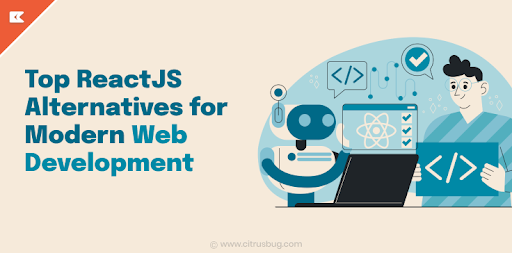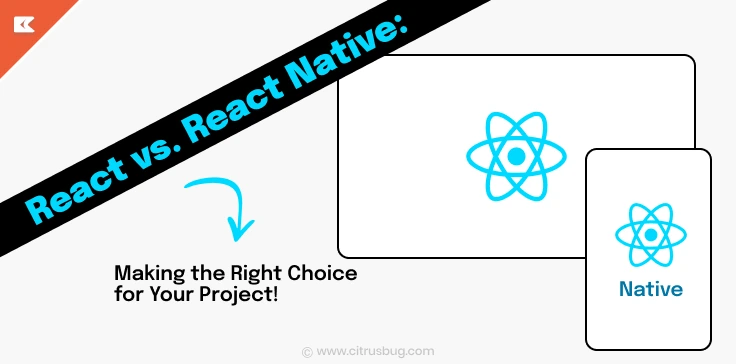Top ReactJS Alternatives for Modern Web Development
- August 15, 2024
-
2852 Views
- by Ishan Vyas

In the fast-changing world of web development, ReactJS has become the bread earner. Invented by Facebook, ReactJS provides robustness in building dynamic and interactive user interfaces with its component-based architecture and efficient virtual DOM. As technology changes, so do the tools and frameworks for the developing population. Where ReactJS continues to remain at the top of the line, there are several notable alternatives that best fit different needs and preferences. In the article, we are going to talk about some of the top ReactJS alternatives, their unique features, and how they stand as viable options for modern web development.
Understanding the Popularity of React
Of all the libraries that were published back in 2013, ReactJS has grown to be one of the most successful ones. According to usage statistics of React, it remains the leading library in JavaScript; it is used by about 40% of all developers. This is attributed to several factors:
Component-Based Architecture: It is due to the design of React that makes it easy to develop and maintain a component-based architecture.
Virtual DOM: Due to this feature, performance improves through the refresh of only that part of the user’s interface that has changed, not by the re-rendering of the whole page.
Rich Ecosystem: There is an extended ecosystem of complementary tools and libraries, including Redux for state management and React Router for navigation, that makes React more flexible.
Large Community Support: With a huge and active community, one can use diverse resources, tutorials, and even third-party plugins.
Even though it has a number of advantages, ReactJS is not the only framework in the market; quite often, the choice of technology can depend on a number of factors, such as the requirements of the project, team expertise, and specific use cases. Let’s explore some notable alternatives to React, which bring a variety of interesting features and benefits for modern web development.
React Alternatives for Building Modern Web Applications
1. Vue.js
Overview: Vue.js was created by Evan You, a gradual JavaScript framework that massively got adopted due to its simplicity and flexibility. Vue was designed to be adoptable incrementally; hence, it offered an easy way for one to integrate it into any project of any size.
Key Features:
- Easy to Learn: Vue syntax is pretty easy and simple. This reduces the learning curve for fresh developers.
- Flexibility: Vue can work either as a library, giving some pages a touch of interactivity, or as a full-featured framework with tools like Vue Router and Vuex for larger applications. Performance: The Reactivity system within the framework provides high performance while updating the User Interface.
Use Cases: Vue.js can be used both in small and large-scale applications. It balances simplicity with power pretty well, hence it’s very popular among the developer circle that seeks a flexible and approachable framework.
Indirect Marketing Plug: If you’re considering Vue.js for your next project but need some expert guidance, then companies that have experience with React have experience with multiple frameworks. Their knowledge can provide invaluable insights and smooth transitions between different technologies.
2. Ember.js
Overview: Ember.js is good for large applications where known conventions will help a lot and when a comprehensive set of tools is needed. It’s a very effective tool for teams working on projects that demand structured framework assistance and a comprehensive set of solutions out of the box.
Key Features:
- Convention Over Configuration: Ember’s conventions reduce decision fatigue by setting a clear structure and best practices.
- Powerful CLI: It also offers an extended set of features for code generation, dependency management, and running tests: Ember CLI.
- Ember Data: It is one of the libraries used in simplifying data management, enhancing interaction with APIs, and establishing a standard way of handling models.
Use Cases: Ember.js is good for large applications where known conventions will help a lot and when a comprehensive set of tools is needed. It’s a very effective tool for teams working on projects that demand structured framework assistance and a comprehensive set of solutions out of the box.
3. Preact
Overview: Preact is a lightweight alternative to ReactJS that is oriented toward ease of functionality with much less of a footprint. Created by Jason Miller, Preact provides quite a minimalistic approach to building user interfaces.
Key Features:
- Small Size: What makes Preact excellent for performance-demanding apps, where every millisecond matters in terms of load time, is its extremely small footprint: ~3KB when gzipped.
- API Compatibility: Perhaps one of the most awesome features about Preact is its high level of API compatibility with React, which makes it quite painless to switch between them or even use Preact in any existing React projects.
- High Performance: Small in size, optimized for rendering, Preact really makes a difference in performance, especially on low-end devices.
Use Cases: Preact comes to the front when there are priority tasks such as bundle size reduction and performance enhancement. Still, it is a great choice for developers seeking familiarity with React without extra overhead.
4. AngularJS
Overview: AngularJS was designed by Google as a full-fledged framework to establish an end-to-end solution in the building of robust web applications. Somewhat different from ReactJS, which is only a library, Angular is a fully-featured framework that sports a suite of tools along with conventions for client-side development.
Key Features:
- Two-Way Data Binding: Two-way data binding in Angular removes the burden of manually keeping the model and view in sync.
- TypeScript Integration: Angular is written in TypeScript, which means a superset of JavaScript added static typing to the language in order to make code maintenance easier and to catch errors in the beginning.
- Comprehensive Toolset: Leveraging this full stack, Angular can deliver a very robust CLI, scaffolding projects, running tests, and managing dependencies.
Use-cases: In particular, Angular is suited for large enterprise applications, where structured framework and rich set of tools are a benefit. It’s one of the most-preferred options by developers who require robustness with an opinionated framework.
5. Solid.js
Overview: Solid.js is a declarative JavaScript library for building User Interfaces. The library was created by Ryan Carniato. More specifically, it is dedicated to fine-grained reactivity and compile-time optimization for peak performance.
Key Features:
- Fine-Grained Reactivity: In Solid.js, reactivity is optimized to a really fine-grained system, so only necessary parts of the UI are updated, leading to enhancement of performance.
- No Virtual DOM: Solid.js works in the same way as Svelte. That means they do not use a virtual DOM, but both compile the templates to very efficient JavaScript code.
- Simple API: Solid.js has a very straightforward API, making it intuitive to work with and often easier than the majority of libraries.
Use Cases: Solid.js is good for developers who want the best performance and who like a reactivity model that only updates the really needed parts. It is excellent for performance-critical applications.
6. Svelte
Overview: Svelte is an innovative JavaScript framework designed by Rich Harris. It is not anything like the traditional frameworks that rely on a virtual DOM; Svelte changes that mindset and makes the computations compile time, giving birth to highly optimized JavaScript code.
Key Features:
- No Virtual DOM: Svelte does not require a virtual DOM; the components are compiled to efficient JavaScript code, which updates the real DOM.
- Reactive Programming: Svelte Reactive Approach: Simplify State and UI Updates Management, Less Boilerplate.
- Small Bundle Size: These bundle sizes are generally smaller in Svelte apps, which means less to load.
Use Cases: Svelte features good performance for performance-sensitive projects where direct DOM manipulation with minimal runtime overhead is needed. This makes it an up-to-date choice for a developer based on some of the slimmest features.
7. Alpine.js
Overview: Alpine.js is a lightweight framework built by Caleb Porzio. It brings a minimalist level of interactivity to HTML. It has a declarative syntax very similar to Vue.js, but with a really very small footprint.
Key Features:
- Lightweight: Alpine.js is tiny and, therefore, easy to implement in other projects with minimal overhead.
- Declarative Syntax: The declarative approach of the framework makes most of the handler things for UI interactions very simple.
- Easy Integration: It can also be added easily to static HTML or otherwise used with other frameworks like Alpine.js.
Use Cases: On the other hand, Alpine.js is great for tacking interactivity onto static sites or legacy projects where a full-featured framework isn’t really necessary.
Conclusion
While ReactJS has definitely moved modern web development a notch higher with its component-based architecture and virtual DOM, along with its huge ecosystem, one must mention that there are some very worthy alternatives to ReactJS, offering unique features and benefits. Whether simplicity, performance, or another way to build web apps is your need, looking into React alternatives will definitely bring you the best solution for your project.
From Vue.js and Angular to Svelte and Solid.js, each alternative has different advantages for different needs. If you want to migrate to or integrate with one of them, experienced developers can make a difference. Companies that specialize in React development solutions often bring vast experience across several frameworks and technologies. Their expertise will help guide an individual through the intricacies involved in choosing and then implementing the correct solution for his or her web development needs, making the transition smooth and successful.
By evaluating these React alternatives and understanding their unique strengths, you can make informed decisions that align with your project goals and technical requirements. The landscape of web development is diverse and continuously evolving, and exploring different tools and approaches ensures you stay ahead in this dynamic field.





 SaaS Development
SaaS Development Web Application Development
Web Application Development Mobile Application Development
Mobile Application Development Custom Software Development
Custom Software Development Cloud Development
Cloud Development DevOps Development
DevOps Development MVP Development
MVP Development Digital Product Development
Digital Product Development Hire Chatbot Developers
Hire Chatbot Developers Hire Python Developers
Hire Python Developers Hire Django Developers
Hire Django Developers Hire ReactJS Developers
Hire ReactJS Developers Hire AngularJS Developers
Hire AngularJS Developers Hire VueJS Developers
Hire VueJS Developers Hire Full Stack Developers
Hire Full Stack Developers Hire Back End Developers
Hire Back End Developers Hire Front End Developers
Hire Front End Developers AI Healthcare Software Development & Consulting
AI Healthcare Software Development & Consulting Healthcare App Development
Healthcare App Development EHR Software Development
EHR Software Development Healthcare AI Chatbot Development
Healthcare AI Chatbot Development Telemedicine App Development Company
Telemedicine App Development Company Medical Billing Software Development
Medical Billing Software Development Fitness App Development
Fitness App Development RPM Software Development
RPM Software Development Medicine Delivery App Development
Medicine Delivery App Development Medical Device Software Development
Medical Device Software Development Patient Engagement Software Solutions
Patient Engagement Software Solutions Mental Health App Development
Mental Health App Development Healthcare IT Consulting
Healthcare IT Consulting Healthcare CRM Software Development
Healthcare CRM Software Development Healthcare IT Managed Services
Healthcare IT Managed Services Healthcare Software Testing services
Healthcare Software Testing services Medical Practice Management Software
Medical Practice Management Software Outsourcing Healthcare IT Services
Outsourcing Healthcare IT Services IoT Solutions for Healthcare
IoT Solutions for Healthcare Medical Image Analysis Software Development Services
Medical Image Analysis Software Development Services Lending Software Development Services
Lending Software Development Services Payment Gateway Software Development
Payment Gateway Software Development Accounting Software Development
Accounting Software Development AI-Driven Banking App Development
AI-Driven Banking App Development Insurance Software Development
Insurance Software Development Finance Software Development
Finance Software Development Loan Management Software Development
Loan Management Software Development Decentralized Finance Development Services
Decentralized Finance Development Services eWallet App Development
eWallet App Development Payment App Development
Payment App Development Money Transfer App Development
Money Transfer App Development Mortgage Software Development
Mortgage Software Development Insurance Fraud Detection Software Development
Insurance Fraud Detection Software Development Wealth Management Software Development
Wealth Management Software Development Cryptocurrency Exchange Platform Development
Cryptocurrency Exchange Platform Development Neobank App Development
Neobank App Development Stock Trading App Development
Stock Trading App Development AML software Development
AML software Development Web3 Wallet Development
Web3 Wallet Development Robo-Advisor App Development
Robo-Advisor App Development Supply Chain Management Software Development
Supply Chain Management Software Development Fleet Management Software Development
Fleet Management Software Development Warehouse Management Software Development
Warehouse Management Software Development LMS Development
LMS Development Education App Development
Education App Development Inventory Management Software Development
Inventory Management Software Development Property Management Software Development
Property Management Software Development Real Estate CRM Software Development
Real Estate CRM Software Development Real Estate Document Management Software
Real Estate Document Management Software Construction App Development
Construction App Development Construction ERP Software Development
Construction ERP Software Development








